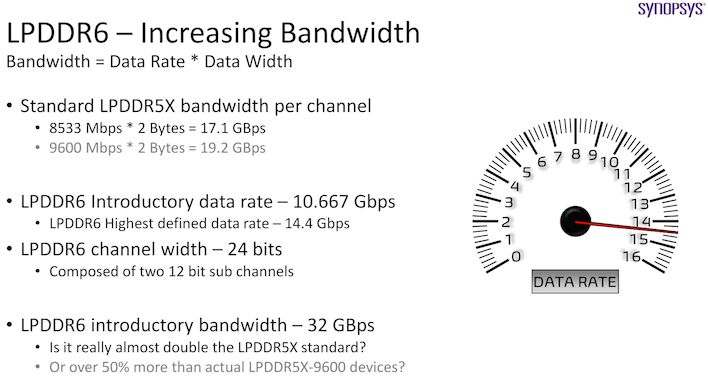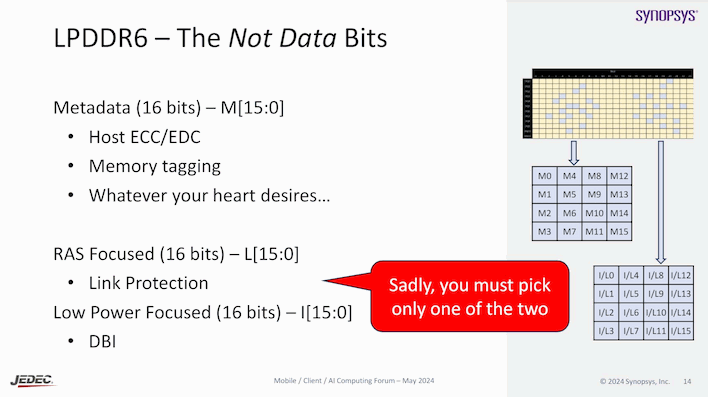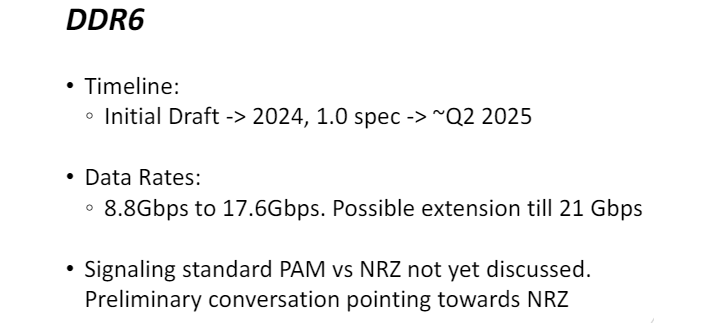Memory is about as close as any computer component gets to being a commodity product. People rarely think about their RAM, as long as it's enough. Memory bandwidth is critically important to PC performance, though. There's a reason Valve upgraded the Steam Deck's memory speed with
the OLED model. LPDDR5X can get up to 10 Gbps, but according to the latest information from JEDEC, (LP)DDR6 is going to blow the current stuff out of the water.
"Yeah, yeah, next-gen memory gets faster," you say, "big whoop." And it's true; the fact that the next memory standard will be faster than the current one isn't exactly shocking news. What makes this information remarkable is the degree of performance gain. Where DDR4 memory officially topped out around 4266 MT/s and the fastest LPDDR5X available
is around 10 Gbps, LPDDR6 is going to
start with a 10.667 Gbps per-pin data rate, and is expected to scale to 14.4 Gbps.
Okay, starting out where we are now might not sound that impressive, but keep in mind that typically a new memory technology actually starts well behind the fastest memory speeds of the current tech. The earliest DDR3 memory supported 800 MT/s transfer rates, while DDR2 memory available for enthusiasts was clocked at 1333 and even 1600. Similarly,
when DDR4 debuted it was the sluggish DDR4-1866, while DDR3 had been hitting 2133, 2400, and even higher speeds for some time.
So saying, for the initial LPDDR6 to outpace the currently-available LPDDR5 memory is very impressive indeed. There's a bit more going on here than just higher clocks, though. In the documentation shared by Darkmont (
@DarkmontTech on Xwitter), LPDDR6 memory appears to use a 24-bit data channel rather than the 16-bit channel used by common LPDDR5. This is because it uses 12 data lines instead of eight, giving a new burst length of 24 bits.
The upshot is that the actual practical bandwidth of LPDDR6 increases by about 33% on a per-clock basis compared to LPDDR5, even after accounting for the fact that only 256 of the 288 bits in a single memory access are actual usable data. Those other 32 bits can be used for special functions that either improve the reliability of the RAM by checking and reporting for write errors, or to do Data Bus Inversion (DBI) that allows you to save a significant amount of power for writes.
Thanks to the increased bandwidth, the 10.667 Gbps per-pin data rate translates to about 28.5 GB/sec of memory bandwidth from a single LPDDR6 IC. If we talk about a typical desktop PC's "dual-channel" memory interface, we're looking at 228 GB/second of memory bandwidth. For comparison,
a PC using DDR5-6400 memory only has 102.4 GB/second of memory bandwidth. In short, LPDDR6 looks like it will roughly double available system memory bandwidth once it hits.
But what about regular old desktop DDR6? The spec for it isn't final yet, but JEDEC's documents suggest that data rates for the socketable RAM could start as high as 8.8 Gbps and then scale all the way to 17.6 Gbps, or perhaps even as high as 21 Gbps. JEDEC's notes suggest that the draft spec for DDR6 should be released this year, and then the spec should be finalized in Q2 of 2025.







